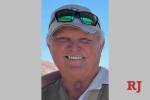Henderson cocktail waitress blames secondhand smoke for her lung cancer
A nonsmoker all her life, Henderson resident Lysa Buonanno got a job as a cocktail waitress at 21. At 40, she was diagnosed with Stage 4 lung cancer.
Buonanno flew to Washington, D.C., March 15 to represent the American Lung Association’s Lung Force initiative, urging policymakers to increase sustained funding for lung cancer research. She was one of 50 people sent there on Lung Force Advocacy Day, which was March 16, to talk about how her life was affected by the disease.
“Lung cancer is the No. 1 cancer killer,” she said. “Lung cancer kills more people than the next four cancers combined, yet it gets a fraction of the funding.”
The National Institutes of Health will spend about $362 million this fiscal year on lung cancer research, according to Harold P. Wimmer, national president and CEO of the American Lung Association. The group would like to see funding increased to at least $450 million by 2020.
“That funding will result in better treatments and improved early detection for people with lung cancer,” he said. “We stood together as a force to press Congress to move forward with robust and sustained federal funding increases for the National Institutes of Health ...”
Wimmer said that, last year, Congress increased the NIH budget by 5 percent. He said it was “good news” that cancer research funding was on the rise, “but we need sustained and predictable research funding increases.”
Shirley Axelrod of Summerlin learned she had lung cancer three years ago. She said if more research dollars had been pumped into stopping the disease, she might not have had to lose the lower lobe of her left lung.
“You’re never the same after that surgery,” she said. “I used to walk 2 or 3 miles a day; now, I’m lucky if I can walk one. And if you get a cold, you may as well prepare to go into the ICU. You’re never the same.”
Buonanno traveled to Washington, D.C., with her daughter, Devin, 16. She told her story to Nevada representatives Joe Heck and Dean Heller and staffers for Harry Reid. That story starts when then-21-year-old Buonanno got a job as a cocktail waitress at a bar near UNLV.
On weekends, it would be packed with as many as 200 people, she said.
“I don’t think it was supposed to hold that many, but we girls used to call it ‘butt to belly button’ busy, trying to walk through (the crowd) to deliver drinks,” she said. “It had a low ceiling and probably not great ventilation back then.”
She estimated that nearly 50 percent of the bar’s patrons smoked. Toward the end of the night, she said her eyes would become irritated and red, her voice scratchy and hoarse.
At her shift’s end, when she stepped out into the night air, it was, she said, “a relief. You felt like you could actually breathe.”
Buonanno moved on to work in other bars, eventually becoming a bartender, breathing secondhand smoke for hours on end for 17 years.
Then one day in 2011, at age 40, Buonanno noticed an ache in her back that wouldn’t go away. It got worse, so she saw a doctor.
He had devastating news: She had lung cancer, which had metastasized to her spine. It was Stage 4 — there are only five stages.
“My first thought was that I wanted to see my daughter graduate high school,” she said. “She was 11 at the time.”
Months earlier, Buonanno had lost a friend to lung cancer. A longtime smoker, Kelly Elmore was 44 when she died. Now Buonanno was facing the same thing.
She said the diagnosis kept her up at night. A runner and a gym rat since middle school, she could think of only one way she got it: from breathing secondhand smoke almost every night for all those years when she worked in bars.
“The hard part was telling my daughter, Devin,” she said. “Initially, I didn’t tell her it was lung cancer. I just told her that I had tumors on my spine.”
According to the American Lung Association, lung cancer is the leading cancer killer in both men and women in the U.S. The American Cancer Society estimates that 158,040 Americans died from lung cancer in 2015, accounting for approximately 27 percent of all cancer deaths, with an estimated 221,200 new cases diagnosed that year.
Buonanno had four surgeries, two of them on her back. She also underwent chemotherapy and radiation, which came with their own concerns.
“My doctor says radiation is the ‘gift that keeps on giving,’ ” she said, explaining how it caused her spine to fracture. She is now on targeted medication, an oral chemotherapy.
But the treatments have kept her in remission for the past 34 months. Buonanno knows that will not last forever, as eventually the cancer will mutate and become resistant to the drug’s effect. Her next option will be a drug in clinical trials, she said.
Between the surgeries and medications, the family’s medical bills ballooned to six figures. One of the drugs she takes costs $12,000 a month, and her co-pay is $2,600 — more than she gets for disability.
“To not be able to have a full-time job at 40 years old is a big mental challenge for me because I’ve always been a workaholic,” she said.
So now what keeps her up at night?
“My family, when I’m gone,” she said. “I’ve come to terms and accepted my illness, but I worry about my kids and my husband — what’s going to happen to them when I’m gone.”
Visit lungforce.org.
To reach Summerlin Area View reporter Jan Hogan, email jhogan@viewnews.com or call 702-387-2949.






























